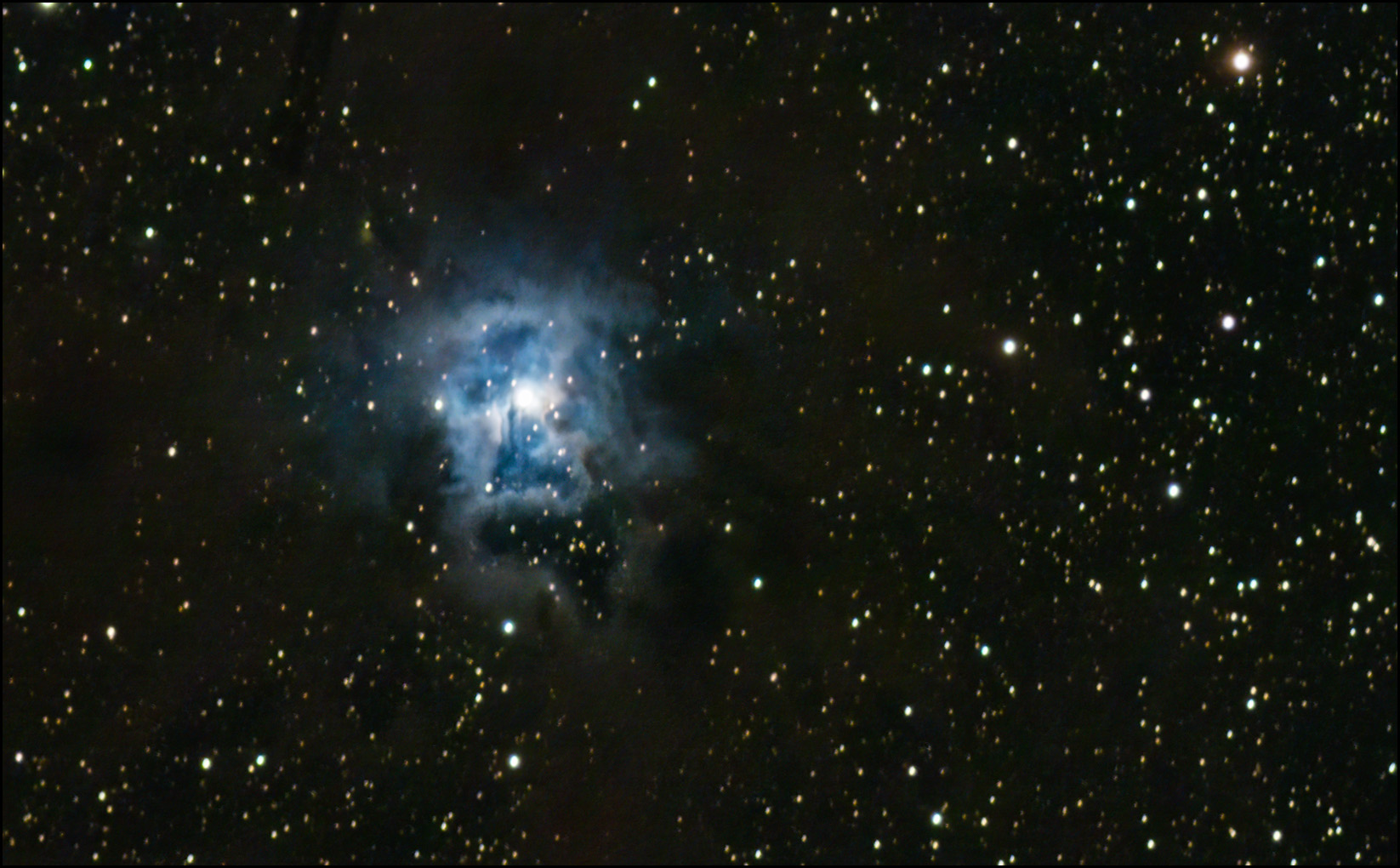This is—finally!—the first real picture I've taken with my new telescope. It's an image of the Iris Nebula (NGC 7023), a reflection nebula in the constellation Cepheus. It's blue thanks to the romantically named SAO 19158, the young star in the center that illuminates it.
This is not a bad image, but it's not as sharp as it should be because, for some reason, I was unable to get autoguiding to work. Once I debug that problem, I'll try again and post the results.
I chose the Iris Nebula for my first serious image because (a) it's very pretty, (b) it's currently high in the sky, and (c) I wanted a nebula that was nice looking and fairly easy to photograph, but wasn't something you've already seen a thousand times. But I'll try some of the more famous ones later.
TECHNICAL INFO: This image is the product of 51 separate exposures of 60 seconds each. It was stacked and processed in Astro Pixel Processor and then finished up in Photoshop. It's remarkable how much better APP was compared to ASTAP, the other stacking/processing program I tried. Like night and day.
I used the defaults in APP because I don't yet understand its options. I just pressed the "Integrate" button and let it run.


Everything looks like a dismayed Donald Trump these days.
That would be orange… not blue.
Please tell us a bit about your scope. Reflector? Refractor? I'd like to think it's a Schmidt or a Maksutov because they are catadioptrics, or "cats" for short. Also the aperture and the mount and cameras you're using.
Coming this weekend!
If you were smart, it would be a Ritchey-Chretien design. It is an open tube so it doesn't require 1000 years to reach thermal equilibrium. It is a Cassegraine with hyperbolic primary and secondary mirrors so there is no need for the Schmidt or Maksutov correcting plates. Those are present because Schmidt and Maksutov designs use spherical primary and secondary mirrors and need something to correct the spherical abberation. There is no spherical abberation in an R-C and it is also free of coma. It gives you a wide field of view in which stars appear as circles, which makes it ideal for deep sky photography. Since Ritchey-Chrétien optics are two mirror optical systems, they have no Spectral Dispersion or Chromatic Aberration, and nothing in the optical path to prevent you from doing UV or long wave IR imaging if you take it into your head to try that. Most research grade instruments are R-C designs, including the Keck and the Hubble. They have the added advantage of being quite short for the focal length that you get.
Mmm, I think Kevin's pretty smart to have it *not* be an RC. Ritchey-Chretiens have no spherical aberration and are free of coma if and only if properly collimated. For an observatory instrument, even a backyard observatory, that's reasonably easy. Though simply Googling "Ritchey-Chretien collimation" will yield a disturbingly high number of completely different how-tos, indicating that it's hardly a slam-dunk.
For an instrument that gets carried out to a site and assembled every time, repeated collimation is the price RC owners pay for their optical qualities, and the affordable RCs from Guang Sheng Optical (which is to say almost all of the ones you'll see from various vendors) share some mechanical quirks that make that process harder than it needs to be.
I should know. I'm getting reasonable performance out of my 8", but it looks like I'm getting some coma and spherical aberration again. I applaud Kevin's decision to go with a refractor.
For now I’ll stick with The Webb, but I am looking forward to the learning curve…
Galileo would be proud!
> It's blue thanks to the romantically named SAO 19158, the young star in the center that illuminates it.
And being blue, it will never be an old star. It will instead "burn up" quickly and then go supernova.
1,300 light years away, in case you were wondering. And it is very pretty.
Quite spectacular!
Pingback: A tour of my telescope – Kevin Drum